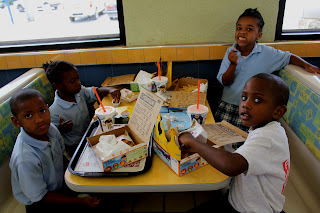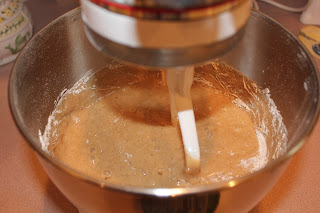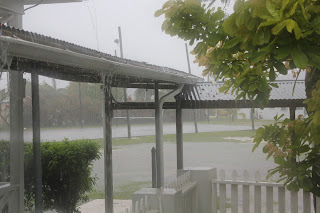This was in the local newspaper (and online) and I just had to share it with you!! If you lived here you probably wouldn't care what type of iguana it was. They are everywhere!! Early Saturday morning I needed to go to the grocery store. When I came home a short time later there were 13 of these critters on the Church roof!! Unbelievable!! But to do this????????????? Totally crazy!!
Department of Environment officer Mat Cottam has a house guest living in his bathroom – a Cayman Brac rock iguana recovering from a broken leg.
Mr. Cottam said it was possible the endangered rock iguana, which was found injured beside South Side Road, was struck by a car. Last month, a pregnant rock iguana was killed when she was hit by a speeding vehicle on Cayman Brac.
Genista Parchman found the injured iguana on Thursday morning, 17 April while out cycling and called the iguana hotline, which is manned by Bonnie Scott-Edwards. Ms Scott-Edwards and agricultural officer Judith Oyog administered first aid to the animal and arranged to fly her to Grand Cayman for treatment.
Cayman Airways Cargo flew the injured iguana from Cayman Brac to Grand Cayman the same day and an X-ray showed the animal had a broken upper right front leg. Vet Andreea Sleahtenea of Island Vets treated the iguana Friday morning while he was under anaesthetic.
The iguana’s broken leg will take up to six weeks to heal, according to Ms Sleahtenea, and the animal needs to be kept very warm during the rehabilitation period and very closely watched.
The iguana was released to Mr. Cottam who has named her Nelson, after the one-armed British Admiral Horatio Nelson. Mr. Cottam is now caring for the animal in his home.
“The DoE does not have a proper animal holding facility at the moment, so I am looking after her in a cage on my porch. The weather of the past few days has been so poor – the rain was pouring in, and she needs to be kept dry, so I had to bring her inside,” Mr. Cottam said last week.
He added: “She is currently in the shower – which is much dryer than the porch. She has a light and a heat mat, but iguanas need sunlight, so she will probably be looking forward to returning to the porch, as much as I am looking forward to getting my shower back.”
Ms Sleahtenea bandaged the iguana’s leg close to the animal’s body, so the torso is effectively acting as a splint.
She said that while blue iguanas are occasionally brought to the vet for procedures and treatment and some people bring in green iguanas, it is rare that a rock iguana from the Sister Islands is treated in Grand Cayman.
Mr. Cottam said rock iguanas are not usually brought to Grand Cayman because it’s possible they could breed with the blue iguanas, therefore a special licence issued under the Endangered Species Trade and Transport Law is required to transport the animals between the islands.
Rock iguanas are indigenous to the Sister Islands and are a separate and distinct breed to the Grand Cayman’s blue iguanas.
Once Nelson recovers, he will be released back into the wild on the Brac, Mr. Cottam said.
This latest incident highlights the threat to the endangered iguanas of the Sister Islands from encroaching development and speeding drivers.
Ms Scott-Edwards said although it was possible Nelson was hit by a car, he may have been injured at a site nearby where land clearing work and landscaping is being done.
She and other volunteers carried out a survey earlier this year to determine exactly how many iguanas live in Cayman Brac, which showed that there were 86 native rock iguanas. That number is now down to 85 after the pregnant iguana was struck and killed last month (see Caymanian Compass, 19 April).
“The increasing numbers of traffic fatalities in the Brac and Little Cayman are a great cause for concern for the future survival of the iguanas there. A pregnant female was killed recently by a speeding motorist on the Brac, and similar incidents are a regular occurrence on Little Cayman. In response to this escalating matter and calls from concerned residents on the Islands, the DoE will be meeting with the National Roads Authority and the Public Works Department to seek advice on measures which might be taken to calm traffic in key areas,” Mr. Cottam said.
Since the closure of Cayman Wildlife Rescue last year, the Department of Environment has been working with volunteers and vets to maintain a basic service for injured wildlife in Cayman.
“With this network of volunteer support and professional experts already in place, the Department of Environment is now seeking a corporate sponsor to help develop basic resources, such as a proper holding area, and to cover medical expenses, towards the reestablishment of a wildlife rescue unit – and helping worthy causes like Nelson,” Mr. Cottam said.

























































